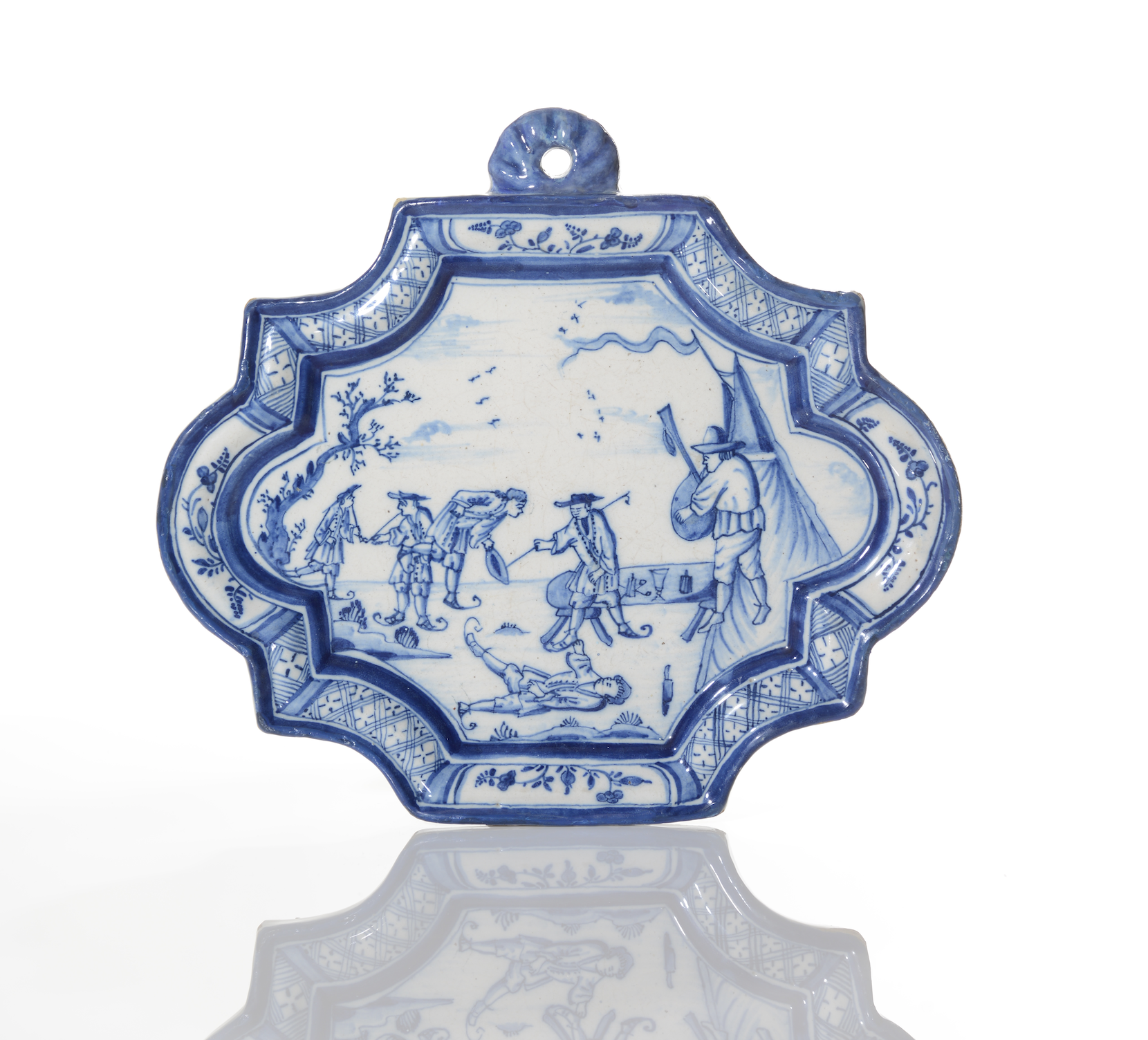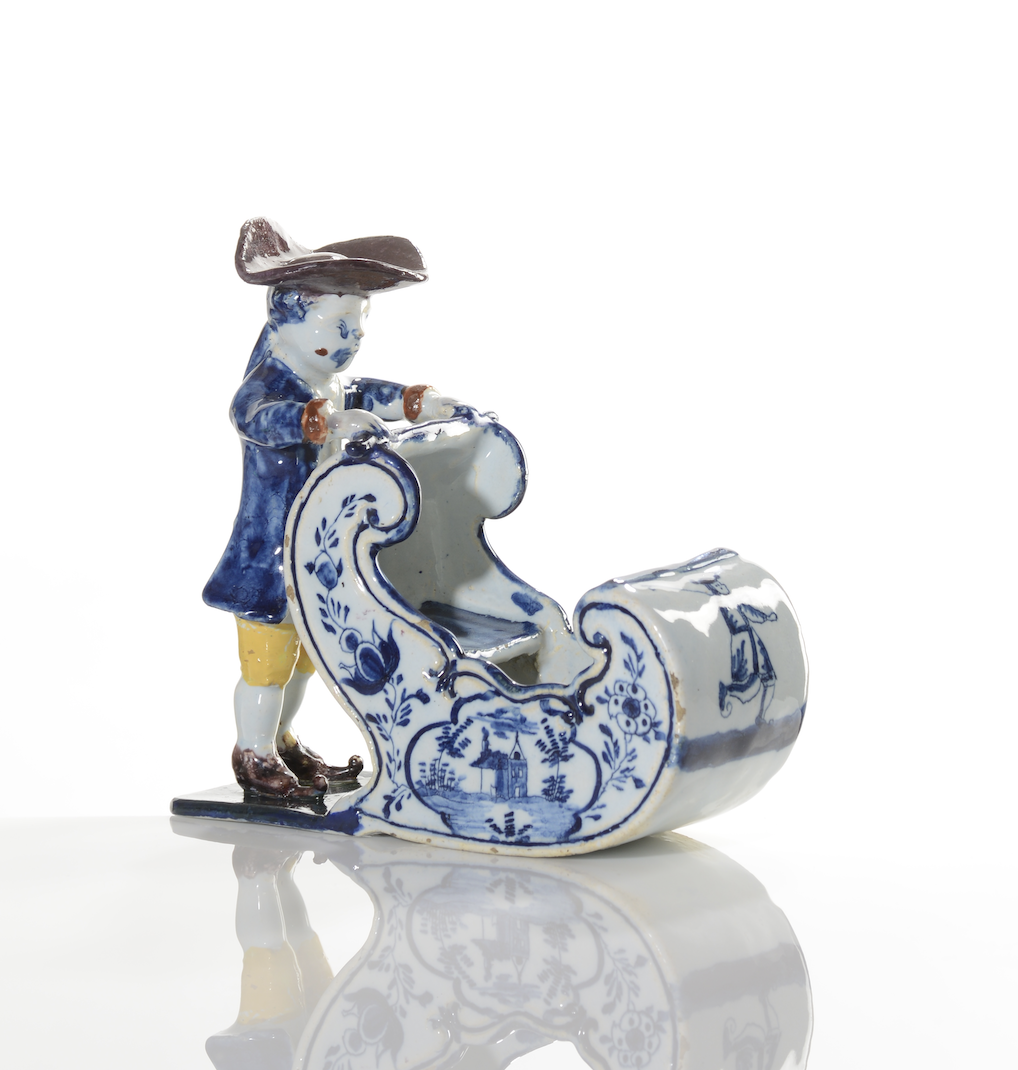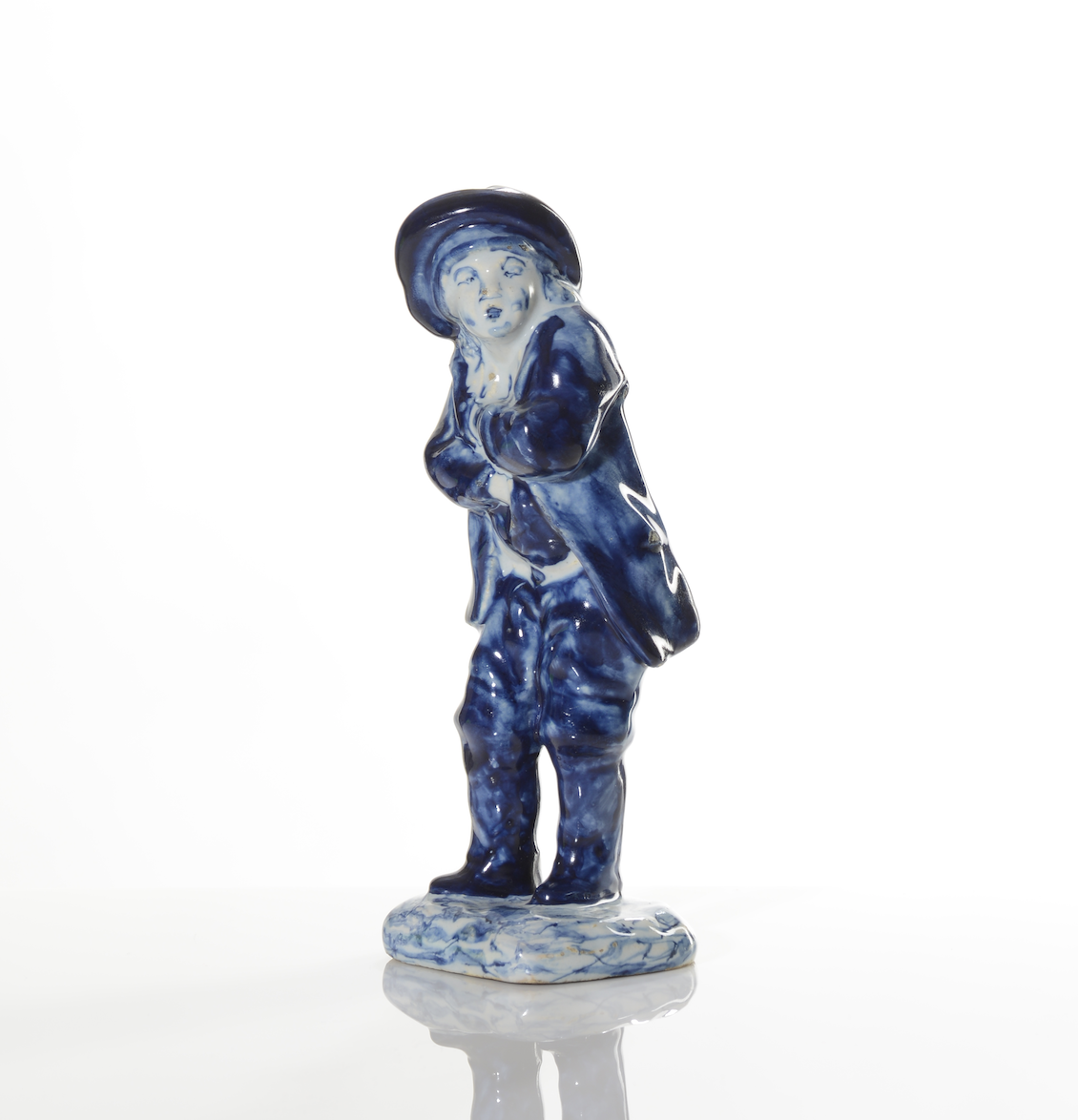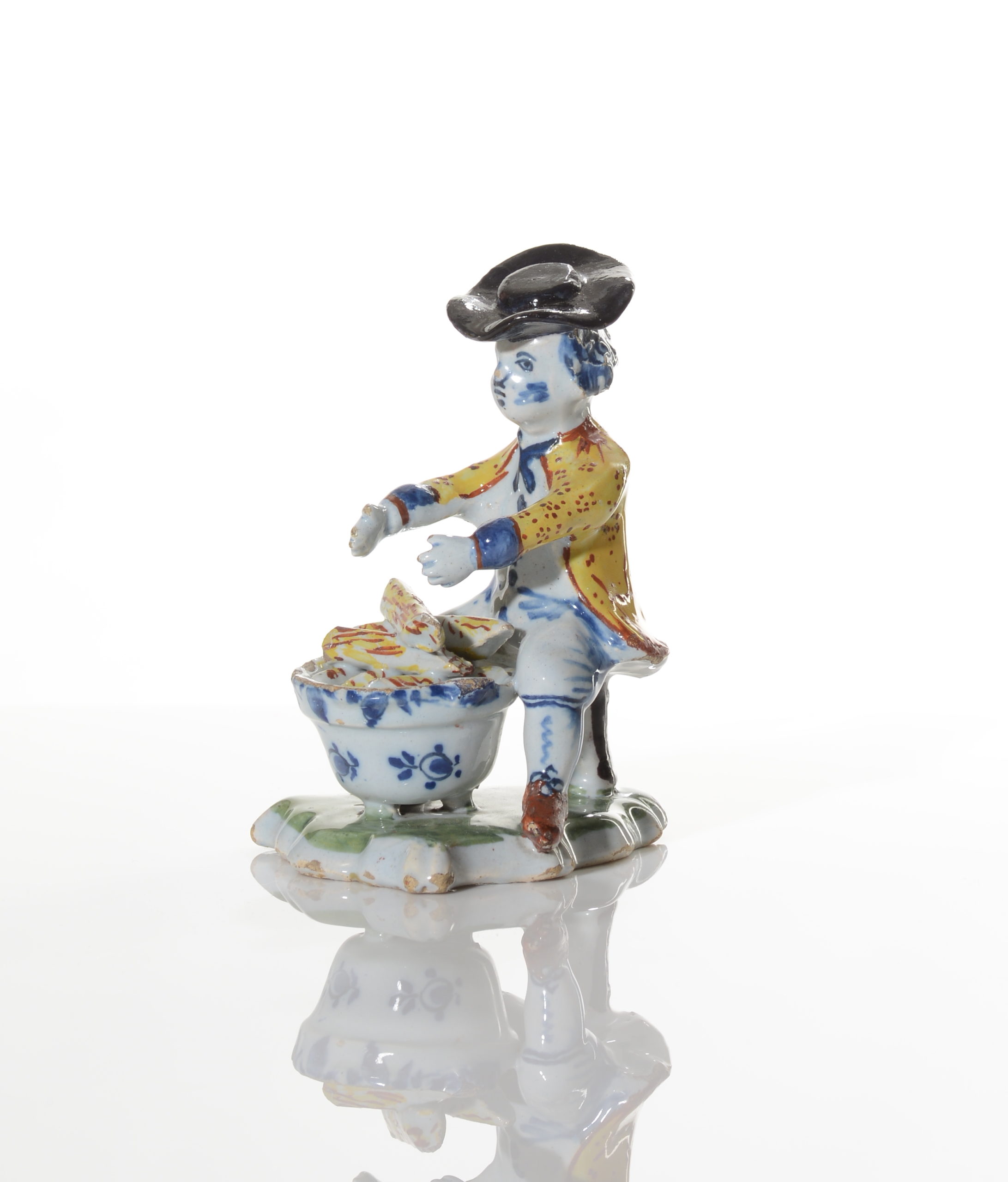
Joy on the Ice on Delftware
Between 1550 and 1850, the Netherlands experienced exceptionally cold winters and relatively cool summers, a period in meteorological history known as the ‘Little Ice Age.’ The storms, freezing cold, ice and snow of these Dutch winters lent themselves to enchanting and atmospheric scenes often portrayed in seventeenth-century paintings. These joyful scenes of snow and ice were also depicted on Delftware objects, such as plaques but also in three dimensional ornamental objects.
 The city canals, puddles and rivers of the Netherlands regularly froze during the winter and provided ideal venues for numerous forms of entertainment. All classes gathered on the frozen ice, from lovers swirling across the ice, to children skating and playing ice golf, the forerunner of ice hockey. Ice golf, or ijskolf in Dutch, was a popular pastime in the Low Countries from the Middle Ages to the Golden Age. It was a game played on ice with a wooden or leather ball and a bat called a club. The sport is depicted in various sixteenth- and seventeenth-century paintings and prints. Also visible on many paintings and on the blue and white plaque is a koek-en-zopie, a refreshment stall that sold food and drink on the ice. The term translates to cake and eggnog, and denotes the free flowing drinks enjoyed during periods of ice skating. The abundance of food and alcohol made skating difficult, as is shown in the foreground of the plaque: a fallen ice skater who lost his hat in the fall.
The city canals, puddles and rivers of the Netherlands regularly froze during the winter and provided ideal venues for numerous forms of entertainment. All classes gathered on the frozen ice, from lovers swirling across the ice, to children skating and playing ice golf, the forerunner of ice hockey. Ice golf, or ijskolf in Dutch, was a popular pastime in the Low Countries from the Middle Ages to the Golden Age. It was a game played on ice with a wooden or leather ball and a bat called a club. The sport is depicted in various sixteenth- and seventeenth-century paintings and prints. Also visible on many paintings and on the blue and white plaque is a koek-en-zopie, a refreshment stall that sold food and drink on the ice. The term translates to cake and eggnog, and denotes the free flowing drinks enjoyed during periods of ice skating. The abundance of food and alcohol made skating difficult, as is shown in the foreground of the plaque: a fallen ice skater who lost his hat in the fall.
 The sleigh ride was another quintessential, and often necessary form of winter entertainment. During treacherous winters, the sleigh was indispensable for getting around or transporting goods but it also became a popular and romantic winter activity. Seated in an ice sleigh, a lady would take a leisurely ride across the ice while propelled by a skating gentleman. This leisurely wintertime activity was often portrayed on plaques, but the Delft potters also modeled small earthenware sleighs after these original ice sleighs. They closely imitated the decoration of the original ice sleighs in their earthenware designs, with painted tasseled square cushions that evoke warmth and comfort. By the early eighteenth century, Delft factories produced blue and white sleighs, and by the mid-eighteenth century, they expanded production with a rich polychrome color palette. The sleighs are often painted with ice skaters, landscapes and floral ornaments. The typical Delft humor is also visible on sleighs with the figure of Harlequin holding a hat in his left hand and pointing to excrement on the ground below. Delft sleighs of this type often have been referred to as pipe stands, however they probably served as decorative objects and not as pipe stands, since pipe stands in Dutch porcelain of circa 1780 have indentations on the front to support the pipe stem, whereas their Delft counterparts do not.
The sleigh ride was another quintessential, and often necessary form of winter entertainment. During treacherous winters, the sleigh was indispensable for getting around or transporting goods but it also became a popular and romantic winter activity. Seated in an ice sleigh, a lady would take a leisurely ride across the ice while propelled by a skating gentleman. This leisurely wintertime activity was often portrayed on plaques, but the Delft potters also modeled small earthenware sleighs after these original ice sleighs. They closely imitated the decoration of the original ice sleighs in their earthenware designs, with painted tasseled square cushions that evoke warmth and comfort. By the early eighteenth century, Delft factories produced blue and white sleighs, and by the mid-eighteenth century, they expanded production with a rich polychrome color palette. The sleighs are often painted with ice skaters, landscapes and floral ornaments. The typical Delft humor is also visible on sleighs with the figure of Harlequin holding a hat in his left hand and pointing to excrement on the ground below. Delft sleighs of this type often have been referred to as pipe stands, however they probably served as decorative objects and not as pipe stands, since pipe stands in Dutch porcelain of circa 1780 have indentations on the front to support the pipe stem, whereas their Delft counterparts do not.
 Wintry figurines, such as this emblematic figure of Winter, were also among the large assortment of the Delftware factories. In this example, a youth is wearing a soft hat, an open jacket and baggy breeches, with his hands tucked into his waistcoat to protect himself against the cold. Interestingly, the figure is atypical for the personification of Winter, which is usually depicted as a wrinkled old man with hoary hair and beard wrapped against the cold. This model has traditionally been attributed to Paul-Louis Cyfflé (1724-1806), a modeler who was employed at the Lunéville factory in France by 1766. A number of his models were made not only in faience and ‘Terre de Lorraine’ (pipe clay), but served as the inspiration for English counterparts made in porcelain at the Chelsea and Derby factories, and in Staffordshire earthenware. Other small genre figures, often modeled as artisans, craftsmen, market folk or this figure seated behind a stove, were inspired largely by German porcelain prototypes, which in turn were derived from graphic sources. Perhaps the most famous group of genre figures is the Meissen porcelain ‘Cris de Paris’ series, which is a series of Parisian street vendors modeled by Peter Reinicke after the drawings by Christoph Huet dated 1753. By the very nature of the medium, the porcelain genre figures, in spite of their humble subjects, have a certain, if accidental, elegance, whereas the Delftware genre figures often have an intentional folkish and amusing character.
Wintry figurines, such as this emblematic figure of Winter, were also among the large assortment of the Delftware factories. In this example, a youth is wearing a soft hat, an open jacket and baggy breeches, with his hands tucked into his waistcoat to protect himself against the cold. Interestingly, the figure is atypical for the personification of Winter, which is usually depicted as a wrinkled old man with hoary hair and beard wrapped against the cold. This model has traditionally been attributed to Paul-Louis Cyfflé (1724-1806), a modeler who was employed at the Lunéville factory in France by 1766. A number of his models were made not only in faience and ‘Terre de Lorraine’ (pipe clay), but served as the inspiration for English counterparts made in porcelain at the Chelsea and Derby factories, and in Staffordshire earthenware. Other small genre figures, often modeled as artisans, craftsmen, market folk or this figure seated behind a stove, were inspired largely by German porcelain prototypes, which in turn were derived from graphic sources. Perhaps the most famous group of genre figures is the Meissen porcelain ‘Cris de Paris’ series, which is a series of Parisian street vendors modeled by Peter Reinicke after the drawings by Christoph Huet dated 1753. By the very nature of the medium, the porcelain genre figures, in spite of their humble subjects, have a certain, if accidental, elegance, whereas the Delftware genre figures often have an intentional folkish and amusing character.
Although the Dutch winters were particularly cold and harsh in the seventeenth and eighteenth centuries, they also brought a lot of fun and offered the Delft potters plenty of inspiration for their objects.



